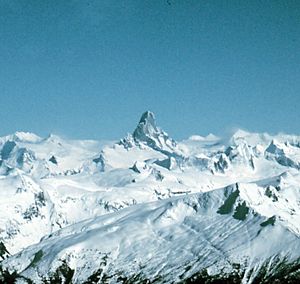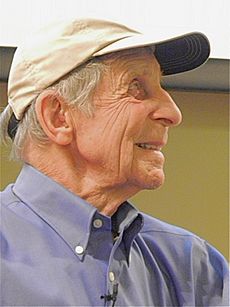Fred Beckey facts for kids
Quick facts for kids
Fred Beckey
|
|
|---|---|

Fred Beckey, circa 1990
|
|
| Born |
Friedrich Wolfgang Beckey
14 January 1923 |
| Died | 30 October 2017 (aged 94) Seattle, Washington, U.S.
|
| Nationality | American |
| Alma mater | University of Washington |
| Occupation | Rock climber, mountaineer, guidebook author |
| Signature | |
Friedrich Wolfgang Beckey (born January 14, 1923 – died October 30, 2017) was an American rock climber, mountaineer, and author. He was known as Fred Beckey. Over seven decades, he made hundreds of first ascents. These were new climbing routes or first climbs to the top of mountains. He explored tall peaks and important routes in places like Alaska, the Canadian Rockies, and the Pacific Northwest. Seven of the "Fifty Classic Climbs of North America" were first climbed by Beckey. He often climbed with some of the best climbers of his time.
Contents
Early life and climbing adventures
Fred Beckey was born in 1923 near Düsseldorf, Germany. His father, Klaus Beckey, was a surgeon, and his mother, Marta Maria Beckey, was an opera singer. In 1925, his family moved to the United States because of money problems in Germany. They settled in Seattle, Washington. Fred's brother, Helmut "Helmy" Beckey, was born in Seattle in 1926. Helmy later became Fred's climbing partner many times.
When Fred was twelve, he climbed Boulder Peak in the Cascades by himself. He had wandered off during a family camping trip. After this, his family signed him up for the Boy Scouts. There, he learned basic climbing skills. Later, he joined The Mountaineers club. In 1939, at sixteen, Fred and two friends climbed 7,292-foot Mount Despair. People thought this mountain in the North Cascades was impossible to climb at the time.
In 1942, the teenage Beckey brothers made the second climb of Mount Waddington. This was then thought to be the hardest climb in North America. After that, Beckey made many more first climbs of peaks in the Olympic and North Cascade mountains. In 1942, he joined the 10th Mountain Division, a special army unit based in Colorado, and worked as an instructor.
After the war, Beckey studied business at the University of Washington. But he still spent a lot of time climbing mountains in the Northwest and desert rocks in the Southwest. After he graduated in 1949, he worked for a newspaper and then sold printing services. However, he soon found that work got in the way of his climbing. For a while, he drove a delivery truck, which gave him more time to climb. As time went on, he decided that climbing was the most important thing in his life. He never married or had children. He never looked for a regular job or tried to get rich. His main goal was always to climb mountains.
In 1955, Beckey joined a big expedition to climb Lhotse. This is the world’s fourth-highest peak, located in the Himalayas. During the trip, his tentmate got very sick at 23,000 feet. This happened the night before they planned to try for the summit. Beckey went down in a snowstorm to get help. But his teammates later blamed him for leaving his partner. Others rescued his partner. Because of this, even though Beckey seemed like a good choice for the first American Everest Expedition in 1963, his former teammates never invited him. After this, Beckey avoided large team climbs in other countries. He preferred smaller climbs, often alone or with just a few friends. He looked for America's last unclimbed peaks or routes that seemed too hard for others. He often climbed 40 or 50 different peaks each year. Over many decades, he achieved almost one thousand first ascents.
Guidebook writer
In the late 1940s, Fred Beckey asked The Mountaineers club in Seattle to publish his first climbing guidebook. This book was about local peaks. They said no. But the American Alpine Club agreed to print a few thousand copies for a set price. Between his climbs, he wrote several books. His most famous work is the Cascade Alpine Guide. This is a very detailed three-volume set of books. It describes the Cascades mountains from the Columbia River to the Fraser River. It is now in its third edition and published by The Mountaineers.
Later achievements and legacy
In 2003, Beckey's 563-page book, Range of Glaciers, was published. This book tells the history of the Cascade region. To write it, he did a lot of research in Washington, D.C.. He looked through files at the Library of Congress and the National Archives. He also checked records from the U.S. Geological Survey and other groups. Beckey also looked at archives in Canada, including those in Ottawa, Ontario and Winnipeg, Manitoba. He even checked records at Yale University and railroad archives in Minneapolis.
Beckey kept climbing even when he was over 90 years old. His life story was made into a documentary film in 2017. It was called Dirtbag: The Legend of Fred Beckey. The film won more than 26 international awards. These included the Best Feature Mountain Film at the 2017 Banff Mountain Film Festival.
A mountain in Alaska was named after him. It's called Mount Beckey. This 8,500-foot peak in the Alaska Range was previously unnamed. It was named after Beckey after he, Calvin Hebert, and John Middendorf climbed it in 1996.
Fred Beckey passed away in Seattle on October 30, 2017, at the age of 94. He died from congestive heart failure.
First ascents

Here is a partial list of some of the important first ascents Fred Beckey made:
- 1939 Mount Despair, North Cascades
- 1940 Forbidden Peak, North Cascades - with his brother Helmy, Lloyd Anderson, Jim Crooks, and Dave Lind.
- 1945 Price Glacier, Mount Shuksan, North Cascades with Jack Schwabland and Bill Granston
- 1946 East Ridge Devils Thumb, Alaska with Bob Craig and Clifford Schmidtke (August 25)
- 1946 Liberty Bell, North Cascades, Washington
- 1947 Mount Hozomeen's South Peak
- 1947 North Peak, Liberty Bell, North Cascades
- 1948 North Ridge of Mount Baker, North Cascades with Fred Beckey, Ralph and Dick Widrig (August 1948)
- 1948 Prusik Peak, North Cascades with Art Holben
- 1954 Northwest Buttress to North Peak, Denali, Alaska (May 27) with Donald McLean, Charles Wilson, Henry Meybohm and Bill Hackett.
- 1954 South Ridge, Mount Deborah with Heinrich Harrer and Henry Meybohm
- 1954 West Ridge Mount Hunter (Alaska) - with Heinrich Harrer and Henry Meybohm
- 1959 Crescent Arete, Mount Owen, Tetons, with Yvon Chouinard
- 1959 Yocum Ridge, Mount Hood, Oregon, with Leo Scheiblehner
- 1960 Outer Space, Leavenworth, Washington with Ron Niccoli
- 1961 North Face of Mount Edith Cavell, Canadian Rockies, Canada with Yvon Chouinard and Dan Doody
- 1961 North Face, Mount Sir Donald, Rogers Pass, British Columbia with Yvon Chouinard
- 1961 Beckey-Chouinard Route on South Howser Tower, Bugaboos, Canada with Yvon Chouinard
- 1961 The Priest, Castle Valley, Utah, with Layton Kor, Harvey Carter, and Annie Carter
- 1962 Question Mark Wall, Lone Peak Cirque, Wasatch Range, Utah
- 1963 Complete North Ridge, Mount Stuart, North Cascades, Washington with Steve Marts
- 1963 Northeast Buttress of Mount Slesse, British Columbia, Canada with Steve Marts and Eric Bjornstad
- 1963 West Buttress (IV 5.8 A1), Musembeah Peak, Wind River Range, Wyoming (September) with Layton Kor
- 1963 Beckey Route, Elephant's Perch, Sawtooth Mountains, Idaho
- 1964 Angel's Crest, The Chief, Squamish, British Columbia
- 1965 Mount Sir Donald, Rogers Pass, British Columbia, First Winter Ascent
- 1966 Mount Seattle, Saint Elias Mountains, Alaska
- 1967 El Matador (NCCS IV, A3), Devils Tower, Wyoming. FA with Eric Bjornstad
- 1968 Direct East Buttress (IV F8 A4), South Early Winter Spire, North Cascades, Washington. FA with Doug Leen
- 1968 South Face (III F8 A1), Cathedral Peak (Washington), North Cascades, Washington. FA with Dave Wagner, John Brottem and Doug Leen
- 1968 Northeast Face, Mount Hooker, Canadian Rockies, Canada. FA with John Rupley
- 1970 Beckey's Spire aka Christianity Spire, Sedona Arizona
- 1970, 1972 Zeus and Moses, Utah. FAs with Eric Bjornstad
- 1970 South Face of Charlotte Dome, III 5.7, FA with Galen Rowell, Chris Jones
- 1972 Moses, Canyonlands with Eric Bjornstad
- 1989 South Buttress, Caliban Peak, Arrigetch Peaks, Alaska
- 1996 Mount Beckey, Cathedral Mountains, Alaska, with John Middendorf and Calvin Hebert
- 1997 Bomber Lake Arete, Wind River Range, Wyoming with Cameron Burns
Other notable ascents
- Second ascent Mount Waddington, British Columbia - 1942
- Triple ascent of Denali, Mount Deborah, and Mount Hunter - 1954
- 1989 South Face of Kedernath, India. Beckey was part of an expedition that made a very close attempt.
Fred Beckey's unique personality
Fred Beckey had a very unique personality. He named Vasiliki Ridge, near Washington Pass, after someone he cared about. Beckey was known as a "dirtbag climber." This means he chose to focus on climbing above everything else, even if it meant not having much money or a fancy home. A famous picture of him shows him trying to hitchhike with a sign that says "Will belay for food." This shows how dedicated he was to climbing. Many climbers knew his reputation, and there was even a T-shirt that said, "Beware of Beckey: He will steal your woman, steal your route." This was a funny way to talk about his strong personality and how he was always looking for new climbs.
Books by Fred Beckey
- Fred Beckey's 100 Favorite North American Climbs (Patagonia Inc., 2011, ISBN: 978-0-9801227-1-8)
- Range of Glaciers: The Exploration and Survey of the Northern Cascade Range (Oregon Historical Society, 2003 ISBN: 0-87595-243-7)
- Cascade Alpine Guide (3 volumes) (Mountaineers Books, 1973–2008)
- Challenge of the North Cascades (1969, 2nd ed. 1996, ISBN: 0-89886-479-8)
- Mount McKinley: Icy Crown of North America (Mountaineers Books 1993, paper 1999, ISBN: 0-89886-646-4)
- The Bugaboos: An Alpine History (1987) (Introduction Only)
- Mountains of North America (1986)
- Mountains of North America (Sierra Club, 1982)
- Darrington and Index Rock Climbing Guide (Mountaineers Books, 1976)
- Guide to Leavenworth rock-climbing areas (Mountaineers Books, 1965)
- Climber's Guide to the Cascade and Olympic Mountains of Washington (American Alpine Club, 1949, revised edition 1953)
See also
- Snafflehound





